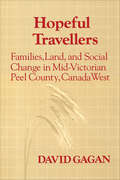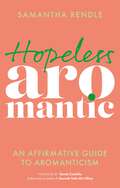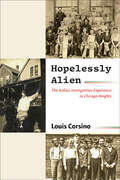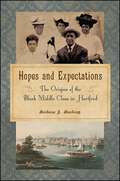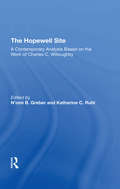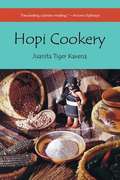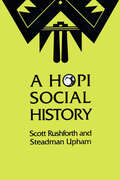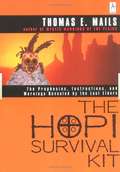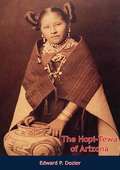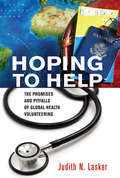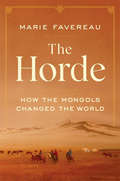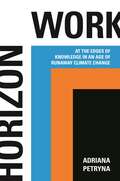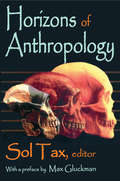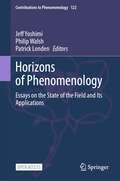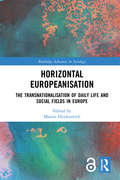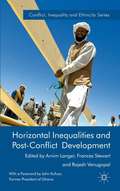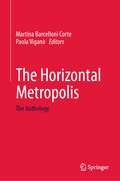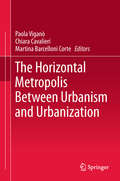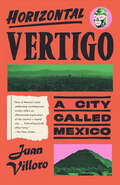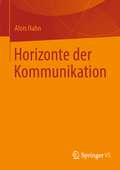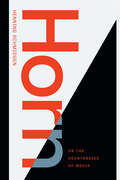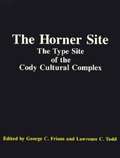- Table View
- List View
Hopeful Travellers: Families, Land, and Social Change in Mid-Victorian Peel County, Canada West
by David GaganIn this exploration of the nature of social reality in a mid-nineteenth-century Upper Canadian farming community, Professor Gagan employs the techniques of historical demography to reconstruct the population of mid-Victorian Peel County – specifically the histories of those families who occupied the county between 1845 and 1875. The evidence will be familiar to anyone who has tried to trace nineteenth-century Canadian family roots, but in this analysis the material is used to answer a broad range of questions related to the central problems of land availability and social change. The author argues that in Peel County, as in the rest of Upper Canada, immigration, settlement, and population growth rapidly changed the previously agrarian frontiers of cheap and abundant farm land into mature agricultural communities. Patterns of inheritance, the timing of family formation, the size and structure of families, the life-cycle experiences of men, women, and children, chances for social betterment, and patterns of vocational and geographical mobility were all linked to the problem of land availability and all underwent subtle changes as rural society attempted to adjust to the new realities of life in the clearings. This book is both s significant contribution to the social history of Ontario and to the growing corpus of comparative, international scholarship on the history of the family.
Hopeless Aromantic: An Affirmative Guide to Aromanticism
by Samantha RendleIf you've picked up this book, the chances are you have some doubts about your Happiness 101 assignment sheet. True love; candlelit dinners; 2.1 children; joint bank accounts - The One? It might make you want to a run a mile - or you might just have a few big questions. Aromanticism is defined as experiencing little to no romantic attraction to others. Sam Rendle, onetime aromantic asexual, sometime aroaceflux, and present-day label unspecified, knows a thing or two about the aro spectrum - and she has some answers for you.You'll explore what aromanticism is, how aromantic people form relationships, how to know if you're aromantic and deal with internalised shame and societal stigma. With a history of aromantic representation, guidance on queerplatonic relationships, and testimony from your worldwide aro family - this is the affirmatory aro companion to have in your back pocket.
Hopelessly Alien: The Italian Immigration Experience in Chicago Heights (SUNY series in Italian/American Culture)
by Louis CorsinoHopelessly Alien is an in-depth study of Italian immigration to Chicago Heights, Illinois, between 1910 and 1950. Drawing upon oral histories, interviews, historical documents, and census materials, Louis Corsino examines the critical concept of hope, which most immigration studies have cast in privatized, psychological terms as the motivation to emigrate in search of a better life. This investigation offers a more contentious, sociological perspective, depicting hope as both an ideological lure to recruit and manage the "foreign element" and as a resource immigrants employed to purchase acceptance and avoid a disparaging label as a "hopelessly alien" stranger. These dialectical processes are illustrated through the Italian immigrants' pursuit of occupational mobility and homeownership, and the appropriation of their children's hopes. Each became forms of cultural capital that demonstrated a public commitment to the American ethos of "joyful striving." Each provided measures of success, but these individual pursuits came at the expense of upsetting the necessary tension between individual and communal hopes.
Hopes and Expectations: The Origins of the Black Middle Class in Hartford
by Barbara J. BeechingWinner of the 2017 Homer D. Babbidge Jr. Award presented by the Association for the Study of Connecticut HistoryBased on a treasure trove of more than two hundred personal letters written in the 1860s, Hopes and Expectations tells the story of three young African Americans in the North. Living on Maryland's eastern shore, schoolteacher Rebecca Primus sent "home weeklies" to her parents in Hartford and also corresponded with friend Addie Brown, a domestic worker back home. Addie wrote voluminously to Rebecca, lamenting their separation and describing her struggle to achieve a semblance of security and stability. Around the same time, Rebecca's brother, Nelson, began writing home about his new life in Boston, as he set out to make a name and a career for himself as an artist. The letters describe their daily lives and touch on race, class, gender, religion, and politics, offering rare entry into individual black lives at that time.Through extensive archival research, Barbara J. Beeching also shows how the story of the Primus family intersects with changes over time in Hartford's black community and the country. Newspapers and census tracts, as well as probate, land, court, and vital records help her trace an arc of local black fortunes between 1830 and 1880. Seeking full equality, blacks sought refinement and respectability through home ownership, literacy, and social gains. One of the many paradoxes Beeching uncovers is that just as the Civil War was tearing the nation apart, a recognizable black middle class was emerging in Hartford. It is a story of individuals, family, and community, of expectation and disappointment, loss and endurance, change and continuity.
The Hopewell Site: A Contemporary Analysis Based On The Work Of Charles C. Willoughby
by N'omi Greber Katharine C RuhlThis book is about Charles Clark Willoughby's studies on the collection of artifacts and field records from the 1891–1892 excavations at the Hopewell Site that were included in the Field Museum. The engineering achievements seen in the geometric earthworks reflect social energy and commitment.
Hopi Cookery
by Juanita Tiger KavenaMore than one hundred authentic recipes center around Hopi staples of beans, corn, wheat, chilies, meat, gourds, and native greens and fruits.
A Hopi Social History
by Scott Rushforth Steadman UphamUsing case studies, A Hopi Social History investigates the mysterious abandonments of the Western Pueblo region in late prehistory, the initial impact of European diseases on the Hopis, Hopi resistance to European domination between 1680 and 1880, the split of Oraibi village in 1906, and some responses by the Hopis to modernization in the twentieth century.
A Hopi Social History
by Scott Rushforth Steadman Upham&“Incorporate[s] a multitude of theoretical approaches about Hopi sociological life . . . Ranging from prehistoric times until contemporary times.&” —Indigenous Nations Studies Journal All anthropologists and archaeologists seek to answer basic questions about human beings and society. Why do people behave the way they do? Why do patterns in the behavior of individuals and groups sometimes persist for remarkable periods of time? Why do patterns in behavior sometimes change? A Hopi Social History explores these basic questions in a unique way. The discussion is constructed around a historically ordered series of case studies from a single sociocultural system (the Hopi) in order to understand better the multiplicity of processes at work in any sociocultural system through time. The case studies investigate the mysterious abandonments of the Western Pueblo region in late prehistory, the initial impact of European diseases on the Hopis, Hopi resistance to European domination between 1680 and 1880, the split of Oraibi village in 1906, and some responses by the Hopis to modernization in the twentieth century. These case studies provide a forum in which the authors examine a number of theories and conceptions of culture to determine which theories are relevant to which kinds of persistence and change. With this broad theoretical synthesis, the book will be of interest to students and scholars in the social sciences. &“A foundation for general discourse on anthropological theory and explanation . . . Covering the prehistoric, Spanish, early historic, and contemporary periods.&” —American Indian Quarterly
Hopi Survival Kit, The
by Mails Thomas E.The Elders of Hotevilla, a remote Hopi reservation in Arizona, are the last of a long line of traditionalists, keepers of a remarkable covenant dating back to 1100 that was created to ensure the well-being of the Earth and its creatures. "The Hopi Survival Kit" preserves the teachings of the Elders and brings them to the world precisely at a time when they are most needed.
The Hopi-Tewa of Arizona
by Edward P. DozierTEWA VILLAGE, the Tewa-speaking community in northern Arizona, is the easternmost pueblo on the Hopi Reservation. It is one of three pueblos on First Mesa; the other two communities are Shoshonean Hopi in speech and culture. Although the inhabitants of Tewa Village speak another language and are set off culturally from the Hopi people, nothing about the outward appearance of the pueblo suggests this separatist quality. Tewa Village, in village plan, in architectural features of the houses, and in dress and material possessions of its inhabitants, appears to be a typical Hopi pueblo. Even in the physical appearance of the Hopi-Tewa no difference between them and the Hopi is apparent. Both belong to a fairly homogenous puebloid physical type. Culturally, however, the two peoples are quite distinct. The analysis of their differences is the main concern of this study.Although abundant literature exists on the Hopi, there is very little information regarding the Hopi-Tewa. Since Tewa Village is a comparatively recent community and its culture is manifestly different from that of the Hopi, those interested in the more colorful and ceremonially richer Hopi culture have bypassed it. The Hopi-Tewa, however, are an important group in themselves, and a study of them is needed.
Hoping to Help: The Promises and Pitfalls of Global Health Volunteering
by Judith N. LaskerOverseas volunteering has exploded in numbers and interest in the last couple of decades. Every year, hundreds of thousands of people travel from wealthier to poorer countries to participate in short-term volunteer programs focused on health services. Churches, universities, nonprofit service organizations, profit-making "voluntourism" companies, hospitals, and large corporations all sponsor brief missions. Hoping to Help is the first book to offer a comprehensive assessment of global health volunteering, based on research into how it currently operates, its benefits and drawbacks, and how it might be organized to contribute most effectively. Given the enormous human and economic investment in these activities, it is essential to know more about them and to understand the advantages and disadvantages for host communities.Most people assume that poor communities benefit from the goodwill and skills of the volunteers. Volunteer trips are widely advertised as a means to "give back" and "make a difference." In contrast, some claim that health volunteering is a new form of colonialism, designed to benefit the volunteers more than the host communities. Others focus on unethical practices and potential harm to the presumed "beneficiaries." Judith N. Lasker evaluates these opposing positions and relies on extensive research--interviews with host country staff members, sponsor organization leaders, and volunteers, a national survey of sponsors, and participant observation--to identify best and worst practices. She adds to the debate a focus on the benefits to the sponsoring organizations, benefits that can contribute to practices that are inconsistent with what host country staff identify as most likely to be useful for them and even with what may enhance the experience for volunteers. Hoping to Help illuminates the activities and goals of sponsoring organizations and compares dominant practices to the preferences of host country staff and to nine principles for most effective volunteer trips.
The Horde: How the Mongols Changed the World
by Marie FavereauAn epic history of the Mongols as we have never seen them—not just conquerors but also city builders, diplomats, and supple economic thinkers who constructed one of the most influential empires in history. The Mongols are widely known for one thing: conquest. In the first comprehensive history of the Horde, the western portion of the Mongol empire that arose after the death of Chinggis Khan, Marie Favereau shows that the accomplishments of the Mongols extended far beyond war. For three hundred years, the Horde was no less a force in global development than Rome had been. It left behind a profound legacy in Europe, Russia, Central Asia, and the Middle East, palpable to this day. Favereau takes us inside one of the most powerful sources of cross-border integration in world history. The Horde was the central node in the Eurasian commercial boom of the thirteenth and fourteenth centuries and was a conduit for exchanges across thousands of miles. Its unique political regime—a complex power-sharing arrangement among the khan and the nobility—rewarded skillful administrators and diplomats and fostered an economic order that was mobile, organized, and innovative. From its capital at Sarai on the lower Volga River, the Horde provided a governance model for Russia, influenced social practice and state structure across Islamic cultures, disseminated sophisticated theories about the natural world, and introduced novel ideas of religious tolerance. The Horde is the eloquent, ambitious, and definitive portrait of an empire little understood and too readily dismissed. Challenging conceptions of nomads as peripheral to history, Favereau makes clear that we live in a world inherited from the Mongol moment.
Horizon Work: At the Edges of Knowledge in an Age of Runaway Climate Change
by Adriana PetrynaA new way of thinking about the climate crisis as an exercise in delimiting knowable, and habitable, worldsAs carbon dioxide emissions continue to rise, Earth’s fragile ecosystems are growing increasingly unstable and unpredictable. Horizon Work explores how climate change is disrupting our fundamental ability to project how the environment will act over time, and how these rapidly faltering predictions are colliding with the dangerous new realities of emergency response.Anthropologist Adriana Petryna examines the climate crisis through the lens of “horizoning,” a mode of reckoning that considers unnatural disasters against a horizon of expectation in which people and societies can act. She talks to wildfire scientists who, amid chaotic fire seasons and shifting fire behaviors, are revising predictive models calibrated to conditions that no longer exist. Petryna tells the stories of wildland firefighters who could once rely on memory of previous fires to gauge the behaviors of the next. Trust in patterns has become an occupational hazard. Sometimes, the very concept of projection becomes untenable. Yet if all we see is doom, we will overlook something crucial about the scientific and ethical labor needed to hold back climate chaos. Here is where the work of horizoning begins.From experiments probing our planetary points of no return to disaster ecologies where the stark realities of climate change are being confronted, Horizon Work reveals how this new way of thinking has the power to reverse harmful legacies while turning voids where projection falters into spaces of collective action and recoverable futures.
Horizons: The World
by Houghton Mifflin HarcourtEvery one of you already holds the important office of citizen. Social studies will help you learn about citizenship. That is why social studies is important in your life."
Horizons of Anthropology
by Sol TaxThe scientific study of human evolution and culture is about a hundred years old. This volume surveys its achievements and methods. Originally published more than forty years ago, the volume's contributors include people who have shaped anthropology's future. As Gluckman says in his Preface, the contributions "point to the horizons of increasing understanding of man, his evolution and his social setting, as seen by a rising generation of scholars."The book includes chapters on how man gradually became different from other primates--on the origin and nature of language and its contribution to our peculiarities as human beings. It surveys the long history of human culture and societies and the theories about their similarities and differences; it discusses human equality and inequality, and it considers, from the anthropologist's point of view, economics, politics, law, religion, medicine, and the arts.In recent decades the various branches of anthropology--physical, cultural, psychological, and social--have become more specialized, and each branch is increasingly linking itself to its appropriate cognate, biological, psychological, or social sciences. Yet there remains a central common field to anthropology, as the science of man, for practitioners in all its branches. This book develops that common interest and deals with the specific problems of various parts of the field. The book brings out the basic nature of anthropology and the extraordinary fascination that lies in the systematic study of the exuberant variety of human societies and customs.
Horizons of Phenomenology: Essays on the State of the Field and Its Applications (Contributions to Phenomenology #122)
by Jeff Yoshimi Philip Walsh Patrick LondenThis is an open access book which explores phenomenology as both an exceptionally diverse movement in philosophy as well as an active research method that crosses disciplinary boundaries. The volume brings together lively overviews of major areas and schools of phenomenology, as well as the most recent applications across a range of fields. The first part reviews the state-of-the-art in various areas of contemporary phenomenology, including several distinct schools of Husserl and Heidegger scholarship, as well as approaches derived from Merleau-Ponty, de Beauvoir, Fanon, and others. An innovative quantitative analysis of citation networks provides rich visualizations of the field as a whole. The second part showcases phenomenology as a living discipline that can advance research in other areas. While some areas of interaction between phenomenology and other disciplines are by now well established (e.g. cognitive science), this volume sheds light on newer areas of application. The goal is to move beyond discussions of philosophical method and highlight scholars who are actually doing phenomenology in a variety of areas, including: Embodiment and questions of gender, race, and identity, The arts (visual art, literature, architecture), and Archaeology and anthropology. This volume offers a concise introduction to cutting edge phenomenological research and is suitable for both students and specialists.
Horizontal Europeanisation: The Transnationalisation of Daily Life and Social Fields in Europe (Routledge Advances in Sociology)
by Martin HeidenreichEuropean integration has transformed the social life of European citizens. Daily life and work no longer take place primarily in a local and national context, but increasingly in a European and transnational frame – a process of ‘horizontal Europeanisation’ which, while increasing the life chances of European citizens, also brings about conflicts among them. This book focuses on processes of Europeanisation in the academic, bureaucratic, professional and associational field, as well as on the Europeanisation of solidarity, networks and social inequalities. Drawing on detailed empirical studies and attending to the reinforcement of centre‐periphery structures in Europe, it analyses the dynamics of horizontal Europeanisation processes, highlighting the crucial role of national practices and perceptions in a transnational context, as well as the related conflicts between the winners and losers in this process. As such, it will appeal to scholars of sociology and political science with interests in European integration, social change and social stratification.
Horizontal Inequalities and Post-Conflict Development
by Arnim Langer Frances Stewart Rajesh VenugopalThis book evaluates the extent to which post-conflict reconstruction has addressed problems of horizontal inequalities through country case studies on Burundi, Rwanda, Nepal, Peru, Guatemala, Bosnia and Herzegovina, and Afghanistan, and four thematic studies on macro-economic policies, privatisation, PRSP's, and employment generation.
The Horizontal Metropolis: The Anthology
by Martina Barcelloni Corte Paola ViganòThis book draws together classic and contemporary texts on the “Horizontal Metropolis” concept. Taking an interdisciplinary approach, it explores various theoretical, methodological and political implications of the Horizontal Metropolis hypothesis. Assembling a series of textual and cartographic interventions, this book explores those that supersede inherited spatial ontologies (urban/rural, town/country, city/non-city, society/nature). It investigates the emergence of a new type of extended urbanity across regions, territories and continents up to the global scale through the reconstruction of a fundamental but neglected tradition. This book responds to the radical nature of the changes underway today, calling for a rethinking of the Western Metropolis idea and form along with the emergence of new urban paradigms. The Horizontal Metropolis concept represents an ambitious attempt to offer new instruction to take on this challenge at the global scale. The book is intended for a wide audience interested in the emergence and development of new approaches in urbanism, architecture, cultural theory, urban and design education, landscape urbanism and geography.
The Horizontal Metropolis Between Urbanism and Urbanization
by Paola Viganò Chiara Cavalieri Martina Barcelloni CorteThis book provides an overview of the Horizontal Metropolis concept, and of the theoretical, methodological and political implications for the interdisciplinary field in which it operates. The book investigates the contemporary emergence of a new type of extended urbanity across regions, territories and continents, up to the global scale. Further, it explores the diffusion of contemporary urban conditions in an interdisciplinary and original manner by analyzing essential case studies. Offering extensive content on the Horizontal Metropolis concept, the book presents a range of approaches intended to transcend various inherited spatial ontologies: urban/rural, town/country, city/non-city, and society/nature. The book is intended for all readers interested in the emergence and development of new approaches in cultural theory, urban and design education, landscape urbanism and geography.
Horizontal Vertigo: A City Called Mexico
by Juan VilloroAt once intimate and wide-ranging, and as enthralling, surprising, and vivid as the place itself, this is a uniquely eye-opening tour of one of the great metropolises of the world, and its largest Spanish-speaking city. Horizontal Vertigo: The title refers to the fear of ever-impending earthquakes that led Mexicans to build their capital city outward rather than upward. With the perspicacity of a keenly observant flaneur, Juan Villoro wanders through Mexico City seemingly without a plan, describing people, places, and things while brilliantly drawing connections among them. In so doing he reveals, in all its multitudinous glory, the vicissitudes and triumphs of the city &’s cultural, political, and social history: from indigenous antiquity to the Aztec period, from the Spanish conquest to Mexico City today—one of the world&’s leading cultural and financial centers. In this deeply iconoclastic book, Villoro organizes his text around a recurring series of topics: &“Living in the City,&” &“City Characters,&” &“Shocks,&” &“Crossings,&” and &“Ceremonies.&” What he achieves, miraculously, is a stunning, intriguingly coherent meditation on Mexico City&’s genius loci, its spirit of place.
The Horizontal World: Growing Up Wild in The Middle of Nowhere
by Debra MarquartIn the tradition of John McPhee and Kathleen Norris, a wry, moving memoir about a family farm, a father, and a daughter, and how you can't not go home again.
Horizonte der Kommunikation
by Alois HahnÜber Kommunikation ist viel kommuniziert worden. Watzlawick schreibt sogar, man könne nicht nicht kommunizieren. Die hier vorgelegte Aufsatzsammlung vereint eine Reihe von Beiträgen, die im Laufe der Jahre in höchst unterschiedlichen Kontexten entstanden sind. Das Thema Kommunikation war oft nicht das Zentrum. Viele Texte entstanden ursprünglich auch in interdisziplinären Kolloquien. Die Arbeiten hier zusammenzufügen entspringt der Absicht, eine vorher teilweise latente Sinnlinie freizulegen. Man könnte von einer Transformation von Publikationen in Spolien sprechen. Das Hauptanliegen ist, einige bislang eher wenig behandelte Horizonte des Themas ins Auge zu fassen, Ränder sozusagen oder Sonderaspekte. Dieser Horizont erscheint bisweilen als Kaleidoskop.
Horn, or The Counterside of Media (Sign, Storage, Transmission)
by Henning SchmidgenWe regularly touch and handle media devices. At the same time, media devices such as body scanners, car seat pressure sensors, and smart phones scan and touch us. In Horn, Henning Schmidgen reflects on the bidirectional nature of touch and the ways in which surfaces constitute sites of mediation between interior and exterior. Schmidgen uses the concept of "horn"—whether manifested as a rhinoceros horn or a musical instrument—to stand for both natural substances and artificial objects as spaces of tactility. He enters into creative dialogue with artists, scientists, and philosophers, ranging from Salvador Dalí, William Kentridge, and Rebecca Horn to Sigmund Freud, Walter Benjamin, and Marshall McLuhan, who plumb the complex interplay between tactility and technological and biological surfaces. Whether analyzing how Dalí conceived of images as tactile entities during his “rhinoceros phase” or examining the problem of tactility in Thomas Pynchon’s The Crying of Lot 49, Schmidgen reconfigures understandings of the dynamic phenomena of touch in media.
The Horner Site: The Type Site of the Cody Cultural Complex (Studies In Archaeology Series)
by George C. Frison Lawrence C. ToddThe dust bowl days of the 1930s extended over a period of seven years and witnessed the removal and wind transport of much of the topsoil on the High Plains, especially in areas that were sandy and where the native sod had been disturbed. <P><P>As the topsoil blew away, human artifacts that were buried and protected by a thick, natural sod cover were exposed and many persons began to collect these specimens. The greatest interest centered around the lanceolate-shaped specimens of exceptional workmanship that were considered to be older than the more common notched varieties. <P><P>Professional archaeologists interested in the High Plains also became aware of this climatic event and the subsequent exposure of artifacts. Paleoindian or Early Man studies in North America had just realized a respectable status with the confirmation of New World man associated with extinct fauna at the Folsom site. <P><P>Radiocarbon dating was yet to be developed but some of the age estimates for Folsom were not too much in error. The unfluted, unnotched projectile points with superior technological attributes were suspected of being quite old, but just how old was still very much conjecture.
